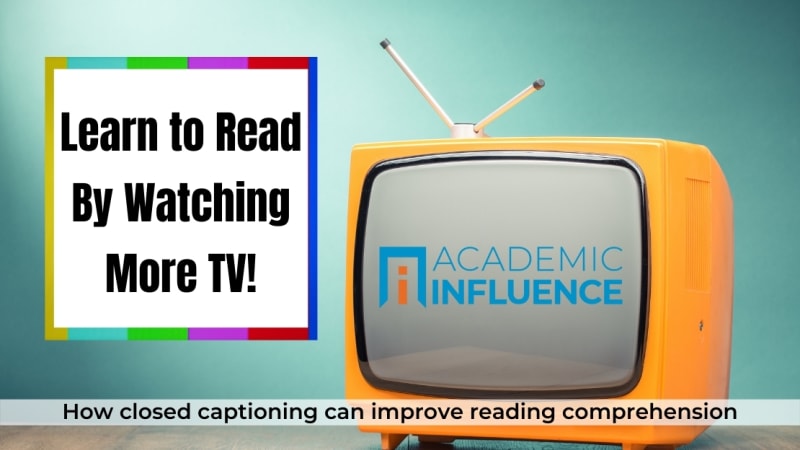Learn to Read By Watching More TV! (How closed captioning can improve reading comprehension)

2020 wasn’t the best year in education for a lot of kids. With the approach of the 2021 school year, teachers everywhere prepared for the return of students with serious learning loss. Many educators lowered their expectations, and selected learning materials reflecting these lower expectations. The experience in our household was a little different. I credit television and YouTube.
According to assessment tests, my kids have typically been strong readers as compared to their peers. My oldest son was slightly above average and my daughter quite a bit above average. My youngest son, whose kindergarten experience consisted entirely of Zoom calls, was doing “okay” with sight words.
COVID also caused constant shifts to our work schedules, which made it hard for my wife and I to be good teachers for our kids. We did the essentials, but it was painful to watch them spend so much time on their computers. Through all of this, we had one requirement for the kids—keep the closed captioning on for everything you watch. To be fair and set a good example, we did the same thing when we watched TV.
Without doing anything more to alter his learning routine, we watched as our youngest son went from struggling with sight words to reading full sentences with compound words, without missing a beat. He even gets the inflection right when he reads questions and exclamations. We were such bad parents (seriously I feel guilty) that we didn’t even know how much his reading had improved until one rainy weekend before school started when he wanted to read a story with my wife. He flew through the book.
Part of me hates to say it, but our youngest learned to read thanks to YouTube! All those hours of watching other kids play Minecraft—alongside other online activities I had generally considered mind-numbing—he was seeing words and hearing them read aloud. And in doing so, he learned to read.
But he’s not the only success story in our household. Now that school has started and the initial state standardized testing scores are back, all of our children have quickly surpassed their peers. Our youngest, who learned to read last year, has exceeded his end-of-year targets, and his teacher says that he could actually meet second grade standards. Our 4th grade daughter is reading at a 5th grade level, and our middle school son who struggled with reading comprehension is in the top percentile now.
Without doing anything more to alter his learning routine, we watched as our youngest son went from struggling with sight words to reading full sentences with compound words, without missing a beat.” – Wayne Downs
Still, these aren’t the only success stories in our households. Unfortunately my wife and I didn’t test our reading speeds at the outset to get a baseline reading, but we both feel like we’ve improved. My wife has always been a strong reader, but she says she feels like she can skim material faster and with better accuracy. I, on the other hand, have always struggled with reading. It doesn’t mean I couldn’t get the job done, but I was slow and as the poster child for adult ADHD, I’ve struggled to focus while reading.
My struggles were real. I did manage to read complex material in graduate school, but I was one of the few grad students visiting the university learning accommodations center. I tried so many methods to help improve my reading—reading aloud, stopping to take notes, listening to audiobook versions of material as I read. I made careful choices about where I read. I even took a speed reading course. These extra efforts helped me “get the job done” but it was painful, took a lot of extra effort, and was oftentimes embarrassing.
When we started our experiment with closed captioning, I found myself unable to keep up with the conversations in just about every show I watched, but particularly with my favorite shows—adult cartoons (yeah, I love ’em). Reading the words of adult cartoons like Rick and Morty was initially a lost cause. They speak too fast and because they say things you don’t expect (this is where the humor is a lot of the time), it makes predicting what will be said a nonviable option.
But I challenged myself. I decided to turn off the sound completely, and read. Months later, I still can’t keep up with every line, but I know I’m getting more than I used to. More importantly, now when I read more typical things like the news, emails, and various other articles, I know that I am getting through them faster, with better comprehension.
...now when I read more typical things like the news, emails, and various other articles, I know that I am getting through them faster, with better comprehension.” – Wayne Downs
Frankly, I’m amazed at what has happened in our household. I’ve never felt better about my reading skills. The bonus icing on the cake—we’re all reading more. No, I haven’t forced my kids to read more. Not one time have I said anything like that. It has just happened. I’m not saying we’re all bookworms now, but today, seeing any one of us with a book in hand is more common than I would have ever expected.
It’s easy and free. Try it. See what happens. Simply turn on your favorite shows, turn the volume down, turn the closed captioning on, and see for yourself. And if you feel inclined, drop us a line to tell us your about experience with this experiment.
And for other helpful tips that can improve your learning outcomes at any age, check out our Guide to College Study Skills.